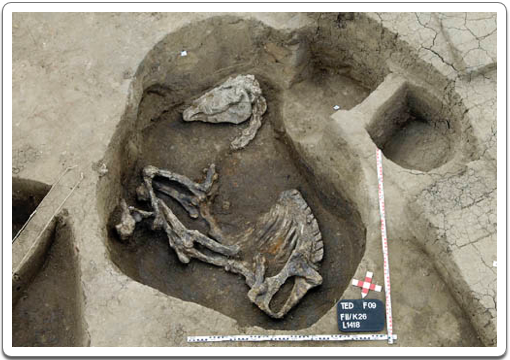During the reign of Amenemhat IV, the penultimate king of the 12th Dynasty, the frequent expeditions to the Sinai came to a sudden stop. This is seen as an indication that a powerful local ruler of foreign origin in the Nile Delta, through which every expedition needed to pass, may have blocked the expeditions’ access to the Sinai.
The fact that Amenemhat IV was not a member of the royal family of the 12th Dynasty, that he does not appear to have justified his kingship by marrying into the royal family, and that his successor was not his son but rather a daughter of Amenemhat III, seems to hint that towards its end, the once powerful 12th Dynasty fell victim to dynastic feuds It is not unlikely for an ambitious local ruler to have taken advantage of this situation to increase his power. At the latest during the reign of Nefrusobek, this ruler was able to found his own dynasty, the 14th, which, ruling from the city of Avaris (assumed to be the modern day site of Tell el-Daba), controlled at least the eastern Nile Delta, and perhaps all of Lower Egypt.
After the death of Nefrusobek, and the end of the 12th Dynasty, kingship over Upper Egypt, the part of Egypt that was not under control of the 14th Dynasty, passed to the eldest son of Amenemhat IV, Sebekhotep I, who is considered to be the first king of the 13th Dynasty.
The initial contacts between both rivalling houses may have been of a military nature, as the military burials of this period in Avaris seem to indicate. After these initial hostilities, a status quo appears to have been agreed and both houses coexisted peacefully, allowing each other access to their territories for trade.

A horse skeleton found in a tomb at Tell el-Daba, presumed to be the ancient city of Avaris, capital of the 14th Dynasty, points towards a military nature of this dynasty.
Source: Bibliai Régészet.
The first kings of the 14th Dynasty appear to have had fairly long and prosperous reigns. Despite their foreign origins, they adopted the traditional royal titulary, and included the name of the Egyptian solar god Re into their own throne names.
This dynasty also seems to have had very good relationships with Nubia and at least one of its kings, Sheshi, may have been married to a Nubian princess.
During the second half of the dynasty, several kings included the words "nourrishment" and "provisions" into their throne names and this seems to indicate that food may have become a very important political factor. There is also a drastic increase in burials at this time, with several tombs functioning as mass graves. This suggests that the latter half of the 14th Dynasty was ravaged by famine and plagues.
The rapid succession of kings at this time may show that even the most powerful could not be protected from illness. The short reigns also destabilised and weakened the central authority of the 14th Dynasty, making it no match for the invading troops of a foreign people known as the Hyksos, who rapidly conquered Avaris and brought the 14th Dynasty to an end.
The list below shows the list of kings of the 14th Dynasty:
- Yakbim (1785-1760)
- Ya’ammu (1760-1750)
- Qareh (1750-1740)
- ‘Ammu (1740-1725)
- Sheshi (1725-1685)
- Nehesi (1685)
- Khakherure (1685)
- Nebfawre (1684)
- Sehebre (1684-1680)
- Merdjefare (1680-1676)
- Sewadjkare (1676-1674)
- Nebdjefare (1674-1673)
- Webenre (1673-1672)
- ///djefare (1672-1671)
- ///webenre (1671-1670)
- Awibre
- Heribre
- Nebsenre
- ///re
- Sekheperenre
- Djedkherure
- Seankhibre
- Nefertem///re
- Sekhem///re
- Kakemre
- Neferibre
- I///re
- Khakare
- Aakare
- Hepu Semenre
- Djedkare Aanati
- Bebnem
several kings, names lost
- Senefer///re
- Men///re
- Djedxxxre
- Inek///
- Apophis I
The following kings also belonged to the 14th Dynasty, but cannot be placed with certainty:
- Jacobher
- Khamure
- Nuya
- Sheneh
- Shenshek
- Wazad
- Yakareb